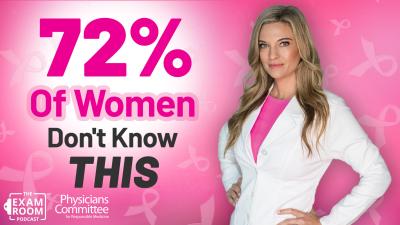Pretty in Pink: As Seen on WJLA-TV (ABC)’s Good Morning Washington

Guest post by Lee Crosby, R.D.
In 2010, my doctor found some suspicious spots in my left breast. A biopsy showed they weren’t cancer, but that I had a higher risk for cancer down the road. My doctor also found a “thickened” area in my right breast she wanted to keep an eye on.
Guest post by Lee Crosby, R.D.
In 2010, my doctor found some suspicious spots in my left breast. A biopsy showed they weren’t cancer, but that I had a higher risk for cancer down the road. My doctor also found a “thickened” area in my right breast she wanted to keep an eye on.
I was only 30 years old, so that got my attention! I was determined to do everything I could to reduce my future risk. While no eating pattern gives 100 percent protection against cancer, I was impressed by research showing that plant-based diets cut cancer risk. I also took up exercise. And all was well for many months.
Then I fell off the wagon. It’s a long story, but I stopped exercising and went back to eating meat. And that "thickened" area they’d been following—which had been stable when I was plant-based. It doubled in size in just four months of eating meat.
Within a week, I was under the knife having a lumpectomy. The results came back “atypical,” or one step before cancer.
Needless to say, I got right back to eating a plant-based diet! I even went back to school to become a registered dietitian, having personally experienced the power of nutrition. It’s been four years since my last surgery, and so far all reports are clear.
While having breast issues was stressful, I’m grateful for the knowledge I’ve gained about reducing breast cancer risk, and I try to pass it along as useful tips for my family, friends, and patients. While research is still developing in the field of diet and disease prevention, this much I know for sure: Wearing a pink ribbon to raise awareness of breast cancer is good, but doing what we can to reduce our risk of getting the disease or having a recurrence is even better.
In fact, The World Health organization finds a healthful diet and lifestyle can help reduce overall cancer risk by 30 percent. Of course, most forms of cancer still result from random mutations—no one is ever to blame for cancer! But thankfully, there are plenty of steps we can take to fight back.
Here are a few ways to start:
- Eat Pink. (And orange and red and green and purple!) By eating most colors of the nutrition rainbow each day, you’ll consume a variety of phytochemicals, like sulforaphane, allyl sulfides, and anthocyanins, which team up to produce healthy genetic material, reduce cell division, and destroy free radicals. While multivitamins and supplements provide a safeguard for nutrients we can easily fall short on, like vitamin D, they don’t provide our bodies with the full spectrum of anti-cancer compounds we can easily get from colorful plant foods.

Photo credit: Steve [at] CommercialImage.net
Rx: Aim to eat seven colors of the nutrition rainbow each day. To get started, try incorporating a few different colors of plant-based foods—like leafy greens, carrots, onions, berries, and beans—into your daily meals. Then experiment with a new vegetable, like purple cauliflower, butternut squash, or Daikon radish, each week.
- Fill Up with Fiber. Fiber—also known as plant roughage—helps support a healthy gut and removes carcinogens, or cancer-forming compounds, from the body. As a bonus, fiber also helps keep us "regular."
Most Americans get about 16 grams of daily fiber, but we should aim for 35 to 40 grams.
Beans, peas, and lentils are fiber superstars! However, fruits, vegetables, and whole grains are also great sources of fiber.

Photo credit: Kathy Patalsky
Rx: Consume at least 35 to 40 grams of fiber a day. Try experimenting with apples, lentils, and soybeans (edamame), which double as quick snacks and add-ons to salads and DIY-meals.
- Pack In Produce. Try to eat two pounds of fresh or frozen produce a day. In fact, some days I aim to eat two pounds of vegetables a day, with fruit on top of that. By shooting for two pounds of vegetables, I know my body is getting plenty of protective phytonutrients without a lot of calories. And I’m never hungry!
In fact, the meal we showcase on WJLA’s Good Morning Washington has three or four pounds of produce but less than 1,600 calories. It also has 55 grams of protein, 72 grams of fiber, four times the recommended daily intake (RDI) of vitamins A, C, and K, and twice the RDI of folate, magnesium, and selenium. Studies find women with the highest intake of carotenoids—think orange and green vegetables—are less likely to develop breast cancer.

Photo credit: Steve [at] CommercialImage.net
Rx: Aim to eat two pounds of produce a day, which is the equivalent to six to eight cups of fruits and vegetables. One easy way to start is by adding leafy greens and vegetables to every meal—even breakfast!
So in addition to donning a pink ribbon this month, try these take-home tips:
- Aim to eat seven colors of the nutrition rainbow each day.
- Fill up with 40 grams of daily fiber.
- Eat two pounds of produce most days of the week.
For additional resources, visit BarnardMedical.org to sign up for free cooking and nutrition education classes or to participate in a free online nutrition program, the 21-Day Vegan Kickstart, which goes live the first day of every month.








